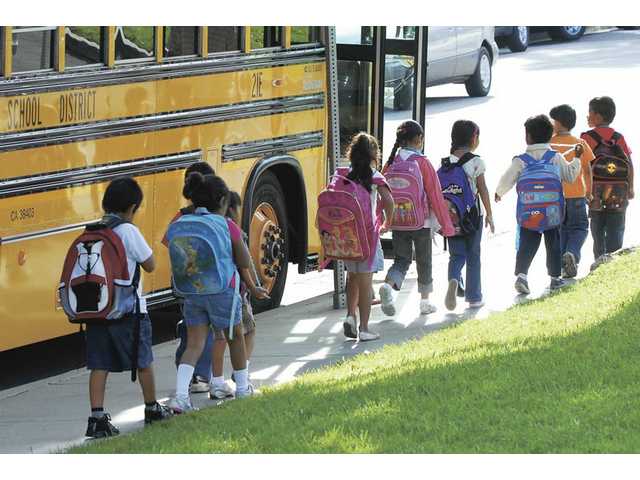
Are America’s vast, sprawling, powerful government agencies really all that bad? Left-leaning New York Times columnist Paul Krugman, in a recent series of columns and blog posts, has passionately leapt to their defense.
“Libertarians are living in a fantasy world,” Krugman wrote over the weekend, arguing that our nation’s major welfare-state programs are “fairly efficient, with low administrative costs.” Even his experiences at the much-maligned New Jersey Motor Vehicle Commission, Krugman insists, “have generally been fairly good.” (My last visit to the local DMV involved a bored-looking lady who insisted on putting the wrong town on my driver’s license, but, hey, who even uses maps anymore?)
So, given that it’s mid-August, let’s discuss another sprawling government program, due to pull in waves of children across the country over the next few weeks. I’m talking about you, public schools. You might be the craziest government program of all.
Here’s the thing: People love public schools, or at least they love the idea of them.
But when you grow up with something crazy—your dad fires your cat out of a cannon every night; your brother plays the bagpipes in the bathtub; your mom wears a T-shirt with Jimmy Carter on it—you tend to think it’s normal. If you were to explain our country’s educational system to a moderately bright space alien, however, they would look at you as if you had three heads.
But when you grow up with something crazy—your dad fires your cat out of a cannon every night; your brother plays the bagpipes in the bathtub; your mom wears a T-shirt with Jimmy Carter on it—you tend to think it’s normal. If you were to explain our country’s educational system to a moderately bright space alien, however, they would look at you as if you had three heads.
With so many oddities in the public school system, it’s hard to know where to start. Across the country, arbitrarily drawn school district lines radically distort real estate markets. Anyone who has shopped for a house in the United States knows one sad truth: Better school districts command a steep premium. (The other truth, it seems, is that you probably won’t like the kitchen.) Despite our government’s lofty rhetoric of free and equal public education, the fact remains that better-off families can buy their way into better schools.
It gets even crazier, because despite this disparity, public school funding doesn’t seem to make much of a difference. The average American public school spends $11,455 per pupil, and that’s is just the average: Washington, D.C., the home of legendarily horrible government schools—among eighth-graders, only 17 percent are proficient in reading and 19 percent proficient in math—spends upward of $18,000 per student. That’s from the U.S. Census Bureau, by the way; after examining the numbers, the Cato Institute estimated that D.C. might spend closer to $25,000 per pupil. Across the board, inflation-adjusted per-pupil spending has tripled since 1970. Test scores have not gone up.
Where does that money go? Well, in 2012, D.C. teachers made an average of $90,681 in salary and benefits. But the real growth in school spending can be found outside the classroom. According to a report from the Thomas B. Fordham Institute, “The Hidden Half: School Employees That Don’t Teach,” non-teaching staff in American public schools spiked 130 percent between 1970 and 2010. Student enrollment for that time period, they note, grew only 8.6 percent. Since 1950, school employees in general—many in “administrative” positions—grew by almost 500 percent.
This week, Morgan Smith, a Texas Tribune reporter, lit up Twitter by posting a sadly revealing photo of a response to her Freedom of Information Request (FOIA) from the Department of Education, signed by an official “FOIA Denial Officer.” Someone’s entire taxpayer-funded job title, in turns out, is devoted to shutting down taxpayer requests for information. Digging from journalist Lachlan Markay soon revealed that our friendly Department of Education “FOIA Denial Officer” makes $155,000 a year. (Whether Paul Krugman would include this in his “low administrative costs” is unclear.)
I haven’t even mentioned the cultural problems endemic in broad-based, broad-brush, one-size-fits-all government schools: fierce battles over curriculum and the Common Core; the fear that your sixth-grader might come home with a lunch box stuffed with condoms helpfully provided by the school nurse; or, even worse, the fear that your child, stuck in a school wracked with gang violence, might not come home at all—all because you can’t afford to leave your ZIP code.
According to the Council for American Private Education, average private school tuition in America is $8,549—thousands less than per-pupil spending at your average struggling public school. The National Center for Education Statistics reports that private schools also consistently outperform public schools on national achievement tests.
School choice, it seems, should be a no-brainer. Why not give families vouchers, allowing them to make free choices for their children’s education? There’s a reason increasing numbers of inner-city activists in places like Chicago and Washington, D.C., are fighting for charter schools and voucher programs. They know choice would be better for their kids. They know the government has failed them.
Ardent defenders of America’s sprawling, failing government school system insist that they want “social justice.” Occasionally, these people are sincere. Sometimes, they’re just lucky enough to live in a neighborhood with “good” public schools. Most often, they’re somehow on the payroll of our vast and growing government-educational complex—like Karen Lewis, the notorious head of the Chicago Teachers Union. She makes $200,000 a year. Let the buyer beware.
Read more: http://www.realclearpolitics.com/articles/2014/08/14/the_crazy_world_of_public_schools_123654.html#ixzz3AMtOfUc8
Follow us: @RCP_Articles on Twitter
No comments:
Post a Comment